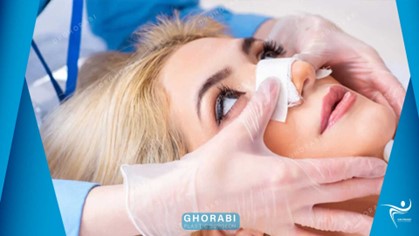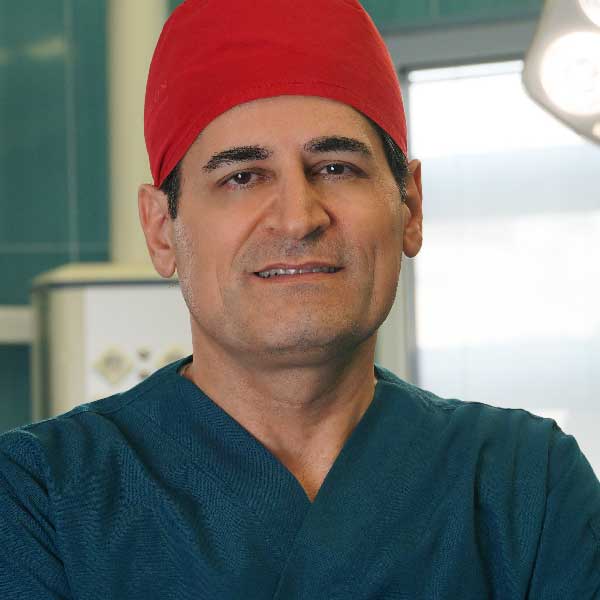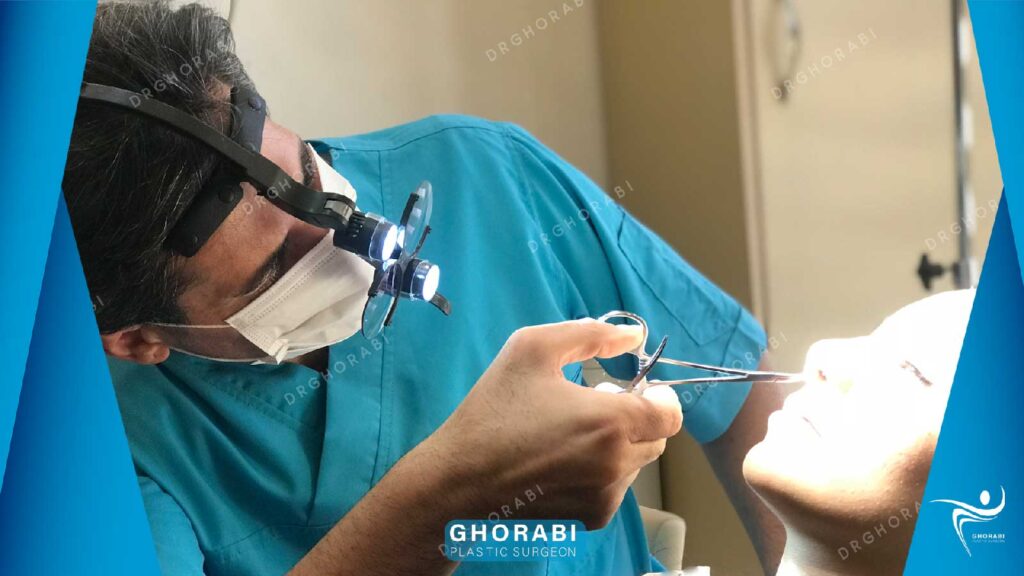Strict compliance with the provided recommendations has a great role in the result of the rhinoplasty surgery. The role of the nose in the respiratory system doubles the need to pay attention to this organ. Paying attention to the principles of care after rhinoplasty will minimize the possibility of complications such as pain, infection and swelling. If the patients are not properly cared for after the surgery, the best results will not be achieved even by choosing the best cosmetic surgeon in the world. Therefore, it can be said:
“Success in rhinoplasty is the result of the complete interaction between the cosmetic surgeon and the applicant”.
Immediately after surgery
Resting is absolutely necessary. Having an adult with you for the first 24 hours is absolutely essential.
In the first week after surgery, when resting and sleeping, use two pillows and try to lie on your back. For better comfort, you can use U-shaped (airplane) pillows.
Remember that it is easier to prevent pain than to control it. So, start taking prescription painkillers before the pain starts.
To achieve optimal results and prevent possible complications, limit your activities for 10 to 14 days after rhinoplasty surgery.
Avoid sudden changes. For example, if you change from a lying position to a standing position, you may feel dizzy. While lying down, first sit for at least one minute, then stand up slowly. If you feel dizzy while sitting or standing, lie down immediately.
Bandage: A small sterile gauze is placed between the nose and the upper lip, which may need to be changed several times during the day. The discharge of blood drops will eventually stop the morning after the operation, and this is completely normal. At the end of the rhinoplasty surgery, a small splint is placed on the upper two-thirds of the nose. While protecting the nose, this splint will help maintain the position of the shaved bones. It is necessary to keep this splint on the nose for about a week. Avoid getting the splint wet so that its effectiveness does not decrease.
During a few days after nose surgery, by regularly consuming fluids and keeping the body hydrated, it prevents nausea and vomiting. Having enough calories and protein in the daily diet plays an important and positive role in the healing process. “Don’t miss a single meal.” Consuming balanced and proportionate food causes:
• Feeling better
• Having more power
• Less discomfort
• Faster recovery
will be.
Decreased daily activity may lead to constipation. To prevent and reduce the possibility of this complication, you can increase the consumption of raw fruit while consuming more fluids so that the fiber in it helps your digestive system. When having a bowel movement, do not strain yourself in any way. If necessary and with the doctor’s prescription, you can use laxatives and stool softeners.
The first week after rhinoplasty

Ice compress: Use ice packs on the nose and eyes in the first 2-3 days to control and reduce swelling and bruising. For this purpose, you can wrap the ice compress in a thin gauze and put it on your nose and eyes.
Swelling: The intensity of swelling or puffiness is more visible two days after the operation. This condition is normal and will appear after any facial cosmetic surgery. There is no need to worry and it will decrease in intensity over a few days.
Bruising: if all the things presented in the recommendations and instructions are followed, the amount of bruising and discoloration around the eyes will be minimized. This bruising usually resolves by the end of the first week.
Nasal congestion: During the first week after rhinoplasty, there is a high possibility of nasal congestion. The effect of external edema on the internal area of the nose causes a slight obstruction of the nasal passage, and this obstruction will decrease slowly at the same time as the edema decreases.
Use the prescribed ointment directly inside the nose twice a day to prevent the inner wall of the nose from drying out and flaking.
It is better to use an ear cleaner dipped in peroxide to clean the inside of the nose, with full caution. Avoid extensive and unnecessary manipulation of the operated nose. Avoid finning as much as possible.
Nasal discharge: In the early days, it is not out of the question to see a small amount of pink discharge. If you see continuous drops of blood, be sure to inform Dr. Gholamhossein Ghorabi.
Bleeding is rarely possible on days 3-5. In this case:
• Lie down
• Raise your head
• Place a cold compress on your nose
• If possible, place a cotton swab dipped in naphazoline inside the nostril
Pain: Pain and discomfort are generally limited to the first 2-3 days after surgery. In most cases, the intensity of the pain is moderate and rarely the patient will experience severe pain. Take prescription painkillers from the first day, and continue as needed.
Appearance of the nose: The tip of the nose may appear slightly raised in the first week after surgery. This condition is temporary and the position of the tip of the nose has little to do with the final result of the rhinoplasty surgery. After a few days and sometimes a few weeks, the tip of the nose will slowly settle into its fixed position. As mentioned earlier, the nasal splint will be removed at the end of the first week.
Exercise: Exercises and exercises should be limited in the first week. Slow movements and daily shopping are recommended. To prevent bleeding, avoid lifting, pulling and pushing heavy objects.
Avoid taking blood thinners (such as aspirin) in the first week after surgery. Alcohol causes severe vasodilation and may increase the swelling of the surgical area and even the possibility of bleeding. It is better to avoid drinking alcoholic beverages for at least one week after surgery.
The stitches are removed after a week and the color of the surgical and cut areas will return to normal. The final period of recovery and emergence and stabilization of the results of rhinoplasty is different for different people and usually takes a year.
After 10 days, you can camouflage the surgical incisions using cosmetics. With the beginning of the sixth week after the surgery, following the instructions and full caution, you can start a gentle massage.

First week onwards
Appearance of the nose: After removing the nasal splint, despite the swelling, you will have the opportunity to see the new shape of your nose. Over the next few weeks, daily changes will be made towards the final result. The appearance of the nose will often resemble the expected shape in 6-8 weeks after surgery. Many factors are effective in the speed of appearance of the final shape of the nose, the most effective of which is the patient’s skin type. Thick and oily skin will maintain edema and swelling for a longer period of time than thin and dry skin.
Activity: In the second week, you must prevent any blow to the nose. Despite the fact that the bones have the necessary strength in their position, even minor blows may lead to their displacement. Avoid positions that may injure the nose.
Sports activities and exercises that increase the heart rate are allowed from the 14th day onwards. Keep in mind that performing sports activities in the first week may increase edema and swelling, and bleeding. After 14 days, brisk walking and working with light weights can be started. After 3 weeks, running is unimpeded. After two months, you can resume full sports activities.
Questions are frequently asked about having a marital relationship during recovery. In response, it can be said that after 12-14 days, you can safely resume marital relations.
Glasses: The use of glasses is not allowed for up to one month. If it is necessary to use glasses, the central bridge of the glasses must be placed on the forehead. In this case, the least pressure is applied to the nasal bones.
Exposure to the sun: Considering that sunburn causes swelling of the nose and delays in reaching the final result, it is recommended to avoid exposure to sunlight for at least two months. Wearing a brimmed hat is essential when walking in the sun. If you are exposed to the sun, be sure to use a cream with at least SPF 25.
After rhinoplasty surgery, it takes about three months for the skin of the nose to regain its full sensation and sensitivity. Activities such as skiing may cause frostbite. Keep in mind that:
Both the sun and the cold have the ability to damage the skin, and as it was recommended to protect the skin from sunburn, you should also be careful about protecting the skin from the cold. Otherwise, the recovery period will be longer and the success rate of the operation may decrease.
Skin: nose surgery, regardless of the patient’s skin type, will increase the fat in the nose. Clean even dry skin 1-2 times a day for two weeks with cotton soaked in special substances prescribed by the cosmetic surgeon.
The presence of minor irregularities under the skin, especially in the nasal bones, is noticeable, which is normal and can be seen even in those who have not had nose surgery.
Availability of the patient: It is better to stay in the city where you performed the surgery for at least one week after the rhinoplasty, so that in case of possible complications, you can visit the surgeon immediately.
Judgment of friends and family: If you are thinking of doing rhinoplasty surgery or your decision to do it is definite, prepare yourself to hear the stories and judgment of your family, friends and family. Most people not only support you to achieve your dreams, but also have stories and disappointing memories up their sleeves for you. Sometimes relatives and friends who know that your decision is final, support you more. After the surgery, almost all of them forget their negative comments and admire the results of the nose surgery.
Look for improvement, not perfection: Few people have perfect limb symmetry. To better understand the issue, pay attention to yourself and those around you. A cosmetic surgeon will never be able to make both sides of the same body completely identical. My goal in cosmetic surgery is to improve the existing situation, not absolute perfectionism.
Final remarks
A slight increase in body temperature immediately after surgery is normal. In case of further changes, inform the medical staff.
In case of nausea or vomiting, inform the medical staff.
Be sure to complete the prescribed course of antibiotics and do not stop taking them thinking that you have completely recovered.
During the period of taking strong painkillers, avoid driving and working with machines. Do not drive or work around machinery until you stop using narcotic pain relievers. Be aware that the consumption of alcoholic beverages enhances the effect of strong painkillers and this combination can be dangerous.
If the pain and discomfort do not subside after 2-3 days, contact Dr. Gholamhossein Gharabi to provide the necessary guidance and recommendations.
The physical, physical, mental, etc. characteristics of each person are unique and no two people are completely alike. So don’t accept the good advice of friends and raise your questions and concerns with Dr. Gholamhossein Ghorabi.
For a week, wear clothes that are closed from the front and back and avoid wearing clothes that are worn from the head.
It is normal to have some anxiety after surgery. Most patients are shocked when they see a swollen and possibly discolored face. Try to be realistic and be sure that these situations and conditions are temporary and will be resolved soon. Relax and let your face heal in peace.
Smoking significantly delays recovery. Try to avoid consuming alcohol for at least 2 weeks after the operation.


